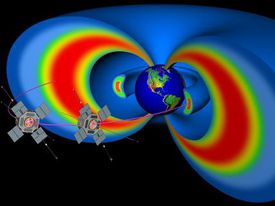
Introduction
Solar flares, eruptions of intense radiation from the Sun’s surface, pose a significant threat to our technological infrastructure, particularly communication systems reliant on satellites and radio waves. The impact of solar flares on these systems can range from disrupting signals to causing long-term damage. To counter these effects, scientists and engineers have developed an array of mitigation strategies to minimize the detrimental impact of solar flares on communication systems.
Understanding Solar Flares
Before delving into mitigation strategies, it’s crucial to comprehend the nature of solar flares. These explosive releases of energy from the Sun result from the reconfiguration of magnetic fields, generating bursts of electromagnetic radiation across various wavelengths, including X-rays and ultraviolet light. When directed towards Earth, these flares can interfere with the ionosphere, affecting radio communications and satellite operations.
Mitigation Strategies
Early Warning Systems
One of the primary approaches involves monitoring solar activity. Specialized observatories such as NASA’s Solar Dynamics Observatory (SDO) and the National Oceanic and Atmospheric Administration’s (NOAA) Space Weather Prediction Center continuously monitor the Sun’s surface for signs of flare activity. Advanced telescopes and satellites enable scientists to predict solar flares, providing crucial warnings to operators of communication systems. Early detection allows for proactive measures to mitigate potential damage.

Redundancy in Satellite Systems
Communication satellites are particularly vulnerable to solar flares due to their exposure to space radiation. To counter this, engineers design satellites with redundant systems and shielding materials. Redundancy ensures that even if one component is affected by a solar event, alternative systems can maintain operations, reducing downtime and service disruptions.
Ground-Based Ionospheric Monitoring
Solar flares can significantly impact the ionosphere, leading to disruptions in high-frequency radio communications. To mitigate this, ground-based monitoring stations observe ionospheric changes in real-time. Adaptive modulation and frequency hopping techniques are employed to dynamically adjust radio frequencies, enabling continuous communication even during solar disturbances.
Hardening Electronics
Electronic components used in communication systems are susceptible to damage from solar radiation. Engineers employ various techniques such as radiation-hardened materials and shielding to protect critical components. These measures increase the resilience of equipment, reducing the risk of malfunctions during solar flare events.

Protocol and Procedure Development
Establishing protocols and procedures for communication system operators is crucial in mitigating the impact of solar flares. Rapid response plans that outline steps to be taken during solar events help in minimizing disruptions. Regular drills and simulations ensure preparedness among personnel to handle potential flare-induced challenges effectively.
Research and Development
Continuous research and development efforts focus on creating more resilient communication technologies. This includes exploring novel materials, designing more robust satellite architectures, and developing advanced signal processing techniques resilient to solar interference.
Conclusion
As our reliance on communication systems grows, so does the need to protect them from the disruptive influence of solar flares. Through a combination of early warning systems, redundancy in satellite design, ground-based monitoring, electronics hardening, protocol development, and ongoing research, scientists and engineers strive to minimize the impact of solar flares on our vital communication infrastructure. By employing these mitigation strategies, we aim to ensure the resilience and continuity of our communication systems in the face of solar flare disturbances.










